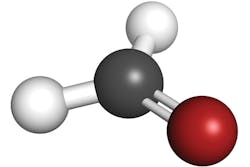Contaminant of the Month: Formaldehyde
What is it?
- Formaldehyde is the common name of a small molecule with chemical formula HCHO. The chemical name is methanal because it is an aldehyde with one carbon atom. Aldehydes have the H-C=O structure.
- The common name derives from names of ants (genus formica), which produce formic acid, HCOOH.
- Formaldehyde’s molecular weight is 30.03 daltons. At atmospheric pressure it is an irritating colorless gas with a boiling point of -2oF.
- It exists in several condensed forms, is very soluble in water and is chemically reactive.
Occurrence, production & use
- Formaldehyde is a major industrial chemical as well as a ubiquitous natural product and metabolite. U.S. production capacity is well over 11 billion pounds per year.
- It is produced by oxidation of methyl alcohol, which is produced by the oxidation of methane.
- It is a component of combustion gases such as those found in forest fires, auto exhaust and tobacco, but the vast majority of environmental formaldehyde is produced by solar oxidation of methane in the upper atmosphere. It can be observed in outer space.
- It has many high volume commercial applications such as in production of formica surfaces, Delrin polyformaldehyde machined parts, melamine formaldehyde, phenol formaldehyde and urea formaldehyde resins used in kitchenware, plywood, particle board, and carpeting.
- It is very reactive and condenses with ammonia and amines, sulfides, DNA and other chemicals.
- Formalin is 40 percent formaldehyde in methanol and water and is used as a tissue preservative.
- It is endogenously formed from metabolism of amino acids.
- Foods such as apples, bananas, cauliflower, meats and fish naturally contain formaldehyde at levels from 6 to 60 milligrams, but its use as a fumigant can also increase residues.
- Indoor air is a much greater source of exposure than outdoor air or water.
Disinfection byproduct
- Water disinfectants such as chlorine, chlorine dioxide and ozone are oxidizing agents, so formaldehyde is among the disinfectant byproducts that are produced.
- Concentrations up to 30 micrograms (µg) per liter (l) with a median of 7.6 µg/l were measured in 227 sites using ozone water treatment.
Health effects
- Inhaled formaldehyde is genotoxic and considered to be a human carcinogen, but ingested formaldehyde is not.
- Inhaled formaldehyde forms cross links of DNA in the nasal turbinates that can be an indicator of the extent of exposure from inhaled occupational exposures.
- Formaldehyde-based building products and furnishings can cause substantial exposures from indoor air. Mobile homes have been a particular concern.
- Formaldehyde is measured in human blood at about 3 mg/l from endogenous metabolic processes.
Analysis
- The U.S. Environmental Protection Agency (EPA) Method 554 uses derivatization with 2,4-dinitrophenylhydrazine and high performance liquid chromatography. The detection limit is 6.2 µg/l.
Water treatment technology
- Water treatment for formaldehyde is not usually performed without a drinking water regulation or guideline.
- Additional oxidation in water would convert formaldehyde to formic acid then carbon monoxide and water. Next, reductive processes would convert it to methanol.
Regulation
- The occupational Permissible Expo-sure Limit is 0.75 parts per million (ppm) in air as an 8-hour time weighted average, and the short term exposure limit is 2 ppm for 15 minutes. Specifications for manufactured products vent formaldehyde.
- The EPA’s Drinking Water Health Advisory includes a conservative lifetime exposure value of 1 mg/l.
- The World Health Organization’s Guidelines for Drinking Water Quality tolerable value is 2.6 mg/l, and it concludes that a guideline is not necessary.
- The potential exposure from drinking water is so small relative to other sources, including endogenous production, that a drinking water regulation would seem to be superfluous.
Dr. Joe Cotruvo is president of Joseph Cotruvo and Associates, LLC, Water, Environment and Public Health Consultants. He is a former director of the EPA Drinking Water Standards Division.
